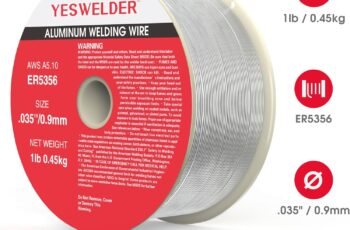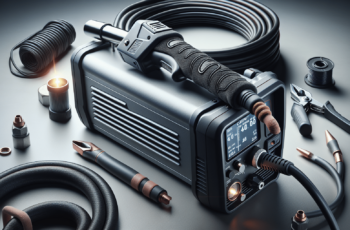Ad Blocker Detected
Our website is made possible by displaying online advertisements to our visitors. Please consider supporting us by disabling your ad blocker.
If you’re navigating the world of fabrication, you know MIG welding machines are indispensable. They’re not just tools; they’re the backbone for joining metals like steel and aluminum. With adjustable duty cycles and precision wire feeds, these machines boost productivity. But what’s the secret to choosing the right one for your needs? There’s more to consider, from power sources to material compatibility, and understanding these nuances can transform your projects.
Key Specifications for MIG Welding Machinery
When choosing MIG welding machinery, understanding key specifications is crucial for optimal performance. You need to focus on power output and duty cycles. Machines offer outputs from 10A to 550A, with a 100% duty cycle at 440A and 60% at 550A. They require a 415V +/-10% 3-phase power input. Look for voltage adjustments with ±3V fine-tuning in synergic modes and a stable current variation within +/-1%. Consider wire feeding systems that support up to 25m/min speeds, offering both manual and automatic settings. For gas shielding, ensure compatibility with argon and CO2 mixtures. Machines should be lightweight, portable, and feature efficient cooling. Ensure the equipment handles materials like steel, stainless steel, and aluminum across various thicknesses for versatile applications. The MIG-205DS-Pro Multi-Process MIG Aluminum Welder is an example of a machine that excels in these areas, offering versatility with its multi-process capability and dual voltage compatibility.
Common Applications in Fabrication Industries
MIG welding machines play a vital role in the fabrication industries, offering unparalleled versatility and efficiency across a wide range of applications.
In structural fabrication, they’re indispensable for high-volume steel construction, creating beams, girders, and frameworks efficiently. They’re also crucial for fabricating pressure vessels, bridges, and industrial plant assemblies due to their precision. The ability to join a wide range of metals and thicknesses makes MIG welding machines highly adaptable to various fabrication needs.
In the automotive industry, MIG welders excel in body panel restoration, exhaust system welding, and frame reinforcements, ensuring cost-effective repairs. They’re perfect for machinery revitalization and railway track resurfacing in material repair.
You’ll find them essential for industrial pipeline fabrication, sanitary piping, and thin-wall tube welding.
Finally, in multi-metal fabrication, they join aluminum and stainless steel, producing corrosion-resistant and aesthetic assemblies.
Importance of Wire Feed Systems and Nozzle Options
The backbone of efficient MIG welding lies in the wire feed systems and nozzle options. You need a motor-driven mechanism to ensure precise wire alimentation, with roll pressure adjustments to prevent wire deformation. Opt for four-roll systems for better grip on thin wires and consider push-pull setups for small-diameter wires to enhance reliability. Drive motor control lets you fine-tune wire speed, crucial for consistent weld bead formation. Ensuring the electrode polarity is set correctly, typically with the gun as +VE and the work as -VE, is vital for optimal performance and adaptability to certain wire types. Nozzle options are equally important. Proper alignment ensures uniform shielding, while heat-resistant materials and integrated gas diffusers maintain nozzle integrity and gas distribution. Regular maintenance, such as replacing clogged nozzles and ensuring tight seals, prevents gas leaks and contamination. Choosing the right nozzle size and maintenance routine reduces downtime and enhances weld quality.
Power Source and Voltage Requirements
Understanding power source and voltage requirements is crucial for optimizing MIG welding machine performance. You’ll find that consumer MIG machines typically run on 120V or 240V single-phase power. However, industrial machines like the Miller® MigMatic® 320i need 400V three-phase inputs for full efficiency. If you use a 120V outlet on machines rated for 240V, expect reduced welding output and duty cycle. Voltage flexibility is a bonus; some machines accommodate both 120V and 240V inputs. Additionally, three-phase systems offer 3× more capacity, supporting higher continuous duty cycles and heavy-duty welding. Ensure your circuits match machine current ratings to prevent tripping and maintain efficiency. Proper wiring and overcurrent protection are essential for safe, efficient operation. 240-volt plugs are similar to those used for ovens and dryers, providing the necessary higher amperage for efficient operation.
Best Practices for Equipment Selection
When choosing a MIG welding machine, consider several key factors to ensure optimal performance and efficiency. First, match the duty cycle with your continuous welding needs to prevent overheating. Choose a machine with an appropriate amperage range based on material thickness, ensuring it meets project demands, from thin metals to heavy steel. Evaluate wire diameter to avoid blockages and ensure stable current flow. Look for multi-voltage options for flexibility in various settings. The power supply impacts the choice of welding equipment, as a standard 240V mains supply limits options to machines up to 110-130 amps, while larger machines require a 16 or 32A supply. Prioritize application-specific features like portability and adjustable wire feed speed. Consider cooling mechanisms suitable for your tasks, opting for water-cooled systems for high-amperage jobs. Check brand reputation, focusing on reliable manufacturers, and ensure the machine includes safety features like over-voltage protection. Align your budget with the project scope, avoiding unnecessary features.
Maintenance and Performance Optimization
Even though maintaining your MIG welding machine might seem routine, it plays a critical role in ensuring optimal performance and extending the equipment’s lifespan.
Start with daily visual inspections: check for cracks, frayed cables, and loose connections. Clean the exterior with a soft cloth, ensuring no dust or metal particles remain.
Regularly replace contact tips and nozzles to prevent restrictions, and inspect wire feed liners for obstructions. Optimize performance by calibrating wire feed tension, ensuring steady gas flow, and managing heat control.
Always store your equipment in a dry, cool area, coiling cables to prevent stress. Keep consumables organized for quick access.
These steps not only maintain your machine’s health but also enhance welding precision and efficiency.
Amperage Range Considerations
Selecting the right amperage range is crucial for achieving quality welds in fabrication. You should follow the guideline of 1 amp per 0.001 inch of material thickness to set a baseline.
For gasless flux core, use specific settings like 70A for 1.0mm. Remember, higher amperage is necessary for thicker materials to ensure full penetration, while excessive amperage on thin metals risks burn-through.
Control the wire feed speed as it directly affects amperage and weld penetration. Smaller wire diameters require lower speeds.
Keep the 6:1 amp-to-volt ratio in mind for stable arcs. Finally, be aware of power supply constraints; exceeding limits can lead to overheating or equipment damage.
Adjust settings through practice for the best results.
Duty Cycle and Its Impact on Performance
Understanding the duty cycle of a MIG welder is essential for maximizing performance and avoiding equipment damage. The duty cycle indicates how long your welder can operate at a given amperage within a 10-minute window before overheating.
For instance, a 60% duty cycle at 200A means you can weld for 6 minutes, followed by 4 minutes of cooling. Ignoring these limits can lead to thermal damage and void warranties.
Effective heat management through fans or liquid cooling can help maintain higher duty cycles. Adjusting amperage affects the duty cycle; lower amps can increase it.
Material and Thickness Compatibility
After mastering the duty cycle to optimize performance, it’s vital to focus on material and thickness compatibility with your MIG welding machine.
You can weld steel and stainless steel using the right shielding gas, while aluminum requires pure argon. For nickel alloys, mix argon with helium, and for copper, consider its high heat conductivity. Titanium demands inert gas protection.
When it comes to thickness, sheet metal up to 14 gauge needs precise control to prevent burn-through, while medium-thick metals are perfect for MIG. However, thick plates over 1/2 inch might require alternative methods.
Aluminum sheets dissipate heat quickly, posing additional challenges.
Ensure your machine handles dual voltage and supports multi-process functions for versatility across different materials and thicknesses.
Enhancing Mobility and Portability
When optimizing for mobility and portability in MIG welding machines, you’ll find that thoughtful design elements play a crucial role. Compact single-phase units and 3-phase multi-process inverters offer lightweight solutions, integrating features like turbo-fan cooling systems and non-live torches to enhance safety and efficiency.
You’ll appreciate modular components like detachable wire feeders that adapt to diverse job sites. For transport, carts with running gears and ergonomic handles make maneuvering larger units effortless.
Aluminum alloy enclosures and inverter technology reduce weight without sacrificing performance. Dual-voltage capabilities and compact spool holders further streamline portability.
These features are particularly beneficial in settings like automotive shops, construction sites, and shipyards, where flexibility and rapid deployment are essential for efficient operation and quick repairs.
Conclusion
You’ve seen how MIG welding machines are indispensable in the fabrication industry, offering versatility and precision for various metals. With the right wire feed systems and nozzle options, you can achieve high-quality welds with ease. When selecting equipment, consider power sources, voltage needs, and amperage ranges to ensure compatibility with your materials. Don’t forget the importance of duty cycles and portability. By making informed choices, you’ll enhance productivity and efficiency in your welding tasks.



